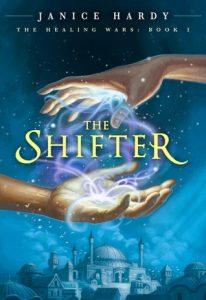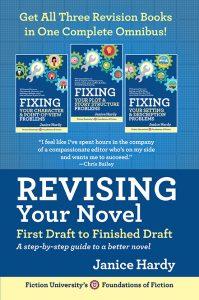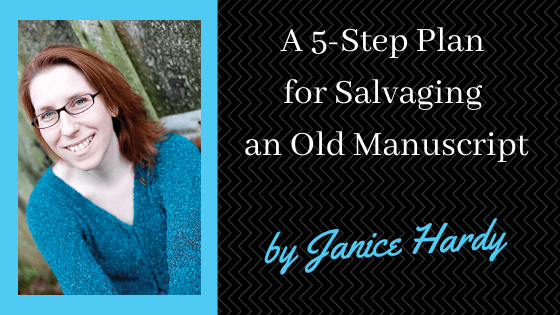A 5-Step Plan for Salvaging an Old Manuscript
April 21, 2020
Note From Rochelle
Dear Writers,
This week, I’m bringing back Write Now! Wednesdays, an almost weekly feature highlighting writing craft and exercises. Tomorrow’s post features the poet Erik Fuhrer and his article “Writing Poetry During the Pandemic.” If you have an idea for a post, message me on Twitter.

Today I’m delighted to welcome Janice Hardy to the blog. She’s the award-winning author of the teen fantasy trilogy The Healing Wars and the founder of Fiction University. If you have a story or a novel stuffed in the proverbial closet, she’s got the solution to help you rescue and revive it!
Happy Writing!
Rochelle
A 5-Step Plan for Salvaging an Old Manuscript
By Janice Hardy
Just because a manuscript is old, doesn’t mean it isn’t worth going back to.
Unless you’re writing your first novel, I’d wager every writer has an abandoned or half-finished manuscript they’d like to go back to one day. Not every idea or manuscript makes it to “finished,” and some ideas we just can’t let go of no matter how many books we write. That early starter novel before we knew what we were doing, a great idea we weren’t able to make work back then, the novel of our heart we just couldn’t find a home for. They languish on hard drives waiting to be rediscovered.
Now is a good time to return to old work.
For many of us, our brains can’t quite handle creating a new novel right now, and that’s okay. Instead of forcing our distracted muses to develop brand-new material, why not pull out one of those abandoned manuscripts and see if you can bring it back to life?

Here are five steps to help you fix an old manuscript.
1. Remind yourself why you stopped working on it.
Maybe you hit a plot wall. Maybe your characters weren’t right. Maybe you lacked a skill to get the story in your head onto the page. Something made you stop working on this manuscript, and it’s better to address it now and find ways to fix it than to run into the same problem again.
Jot down what it needs or what you want to work on.
Focus on the big picture issues for now—use what you remember and any notes you might have made when you were still drafting it. Is the concept still good? Is the core conflict strong enough? Are the characters the right ones? Are the stakes high and personal enough? Is it more premise than plot? Is it more character arc than character with a problem? There are plenty of reasons why a first draft didn’t work.
It’s okay if you aren’t sure how to fix it at this stage—the whole point here is to look for the flaws and problems so you have a direction on how to revise.
2. Outline the major plot points—new or old.
Odds are, the reason you’re looking at this manuscript again is because you still love the story or concept. I’ve found it helpful to brainstorm a new big-picture plot using that idea, because it allows me to look at the idea and not what I already wrote.
This is an opportunity to replot the story, not redo what didn’t work.
The moments you remember are most likely the ones that worked or resonate with you in some way. The ones you don’t really remember probably weren’t serving the story and are good candidates to cut. Replotting it anew will let you take what was good and build on that, without having the existing plot or concept drag it back down.
If you’re looking for help with plotting or revising, I have two free online workshops available right now.
3. Read the manuscript with a critical eye, and take notes on what’s good and what’s not so good.
Once you’ve brainstormed the big picture moments, it’s time to take stock of what you actually wrote. It’s fun (and helpful for objectivity) to read the manuscript as if critiquing a friend’s work. What advice would you give this writer? What lines made you smile? What characters did you like or dislike? Be as objective as you can.
When done, create an editorial map so you know what you already have.
Go through each scene and summarize it. Pay particular attention to the plot mechanics—the goal, the conflict, the stakes, the motivations. Is this idea more premise than plot? Are the characters plausibly motivated or just doing what the plot tells them to? Does every scene have a conflict? Is it a strong enough conflict to keep the plot moving?
Also look at the character arc (if you have one). Is there a high percentage of scenes that focus on the internal arcs and not the external problems? That could be why the story stalled the first time. It’s hard to plot with internal goals—it’s the external actions that drive a plot.
4. Delete what isn’t working—even if you like it.
This is the toughest step. There are reasons you never finished this manuscript, and those reasons must be pruned away for the story to grow.
Save the file under a new name and delete what doesn’t need to be there. You’re still thinking big-picture, so cut whole scenes, and large chunks of text. Individual word choices can be edited after the story is working, so concentrate on the scenes, subplots, and even characters who aren’t serving the story.
Great scenes are bad for the novel if they don’t serve the story you want to tell.
There will be scenes in this group that you love. Cutting them will be hard, I know, I’ve done it myself. You’ll want to save them, and might even go to great lengths to find a way to force it back into the novel.
But great scenes don’t have to be forced. They exist because they naturally drive the plot or character arc forward and work with the overall story. Save them if you want to, and keep an eye out for a way to maybe use them later, but accept that they probably don’t have a home in this manuscript anymore.
5. Create a new outline, synopsis, or plan with your new ideas.
This is an optional step, as pantsers might be ready to dive in and start working at this point. But even so, if the draft is written and needs revising more than rewriting, an outline is useful no matter what your process.
An outline lets you know the book is working before you put more time into it.
In many ways, outlining and scene summarizing is brainstorming on paper, allowing you to “write” the story without going into the details of an actual draft. You can pursue goals and subplots, see where a plotline might take you, and hash out all the easy “first ideas” that come to you. Once those first ideas are out, you’ll be able to dig deeper and find the real ideas that will turn the story into what you envisioned it could be.
Old manuscripts often have hidden gems lurking under dusty pages that never went anywhere. If an old idea keeps poking at you to reconsider it, maybe now’s the time to revisit it.
Do you have an old manuscript you want to salvage?

 About the author. Janice Hardy is the award-winning author of the teen fantasy trilogy The Healing Wars, including The Shifter, Blue Fire, and Darkfall from Balzer+Bray/Harper Collins. She also writes the Grace Harper urban fantasy series for adults under the name, J.T. Hardy. When she’s not writing fiction, she runs the popular writing site Fiction University, and has written multiple books on writing, including Understanding Show, Don’t Tell (And Really Getting It), Plotting Your Novel: Ideas and Structure, and the Revising Your Novel: First Draft to Finished Draft series. Sign up for her newsletter and receive 25 Ways to Strengthen Your Writing Right Now free.
About the author. Janice Hardy is the award-winning author of the teen fantasy trilogy The Healing Wars, including The Shifter, Blue Fire, and Darkfall from Balzer+Bray/Harper Collins. She also writes the Grace Harper urban fantasy series for adults under the name, J.T. Hardy. When she’s not writing fiction, she runs the popular writing site Fiction University, and has written multiple books on writing, including Understanding Show, Don’t Tell (And Really Getting It), Plotting Your Novel: Ideas and Structure, and the Revising Your Novel: First Draft to Finished Draft series. Sign up for her newsletter and receive 25 Ways to Strengthen Your Writing Right Now free.
Website | Facebook | Twitter | Pinterest | Goodreads | Amazon | Barnes & Noble | iTunes | Indie Bound










Thanks so much for having me!